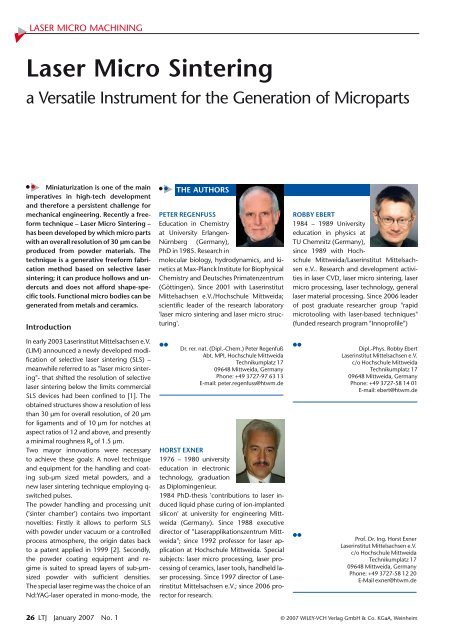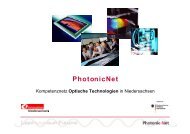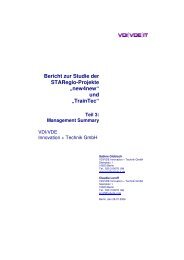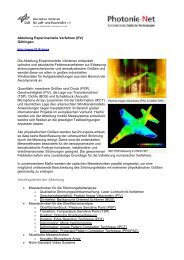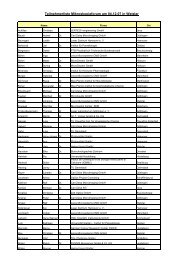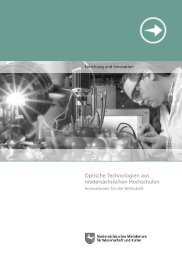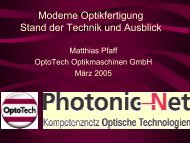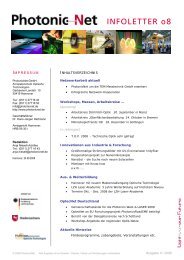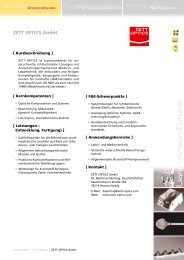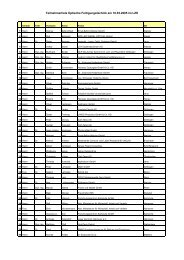Laser Micro Sintering - PhotonicNet GmbH
Laser Micro Sintering - PhotonicNet GmbH
Laser Micro Sintering - PhotonicNet GmbH
Create successful ePaper yourself
Turn your PDF publications into a flip-book with our unique Google optimized e-Paper software.
LASER MICRO MACHINING<br />
<strong>Laser</strong> <strong>Micro</strong> <strong>Sintering</strong><br />
a Versatile Instrument for the Generation of <strong>Micro</strong>parts<br />
Miniaturization is one of the main<br />
imperatives in high-tech development<br />
and therefore a persistent challenge for<br />
mechanical engineering. Recently a freeform<br />
technique – <strong>Laser</strong> <strong>Micro</strong> <strong>Sintering</strong> –<br />
has been developed by which micro parts<br />
with an overall resolution of 30 µm can be<br />
produced from powder materials. The<br />
technique is a generative freeform fabrication<br />
method based on selective laser<br />
sintering; it can produce hollows and undercuts<br />
and does not afford shape-specific<br />
tools. Functional micro bodies can be<br />
generated from metals and ceramics.<br />
Introduction<br />
In early 2003 <strong>Laser</strong>institut Mittelsachsen e.V.<br />
(LIM) announced a newly developed modification<br />
of selective laser sintering (SLS) –<br />
meanwhile referred to as "laser micro sintering"-<br />
that shifted the resolution of selective<br />
laser sintering below the limits commercial<br />
SLS devices had been confined to [1]. The<br />
obtained structures show a resolution of less<br />
than 30 µm for overall resolution, of 20 µm<br />
for ligaments and of 10 µm for notches at<br />
aspect ratios of 12 and above, and presently<br />
a minimal roughness R a of 1.5 µm.<br />
Two mayor innovations were necessary<br />
to achieve these goals: A novel technique<br />
and equipment for the handling and coating<br />
sub-µm sized metal powders, and a<br />
new laser sintering technique employing qswitched<br />
pulses.<br />
The powder handling and processing unit<br />
('sinter chamber') contains two important<br />
novelties: Firstly it allows to perform SLS<br />
with powder under vacuum or a controlled<br />
process atmosphere, the origin dates back<br />
to a patent applied in 1999 [2]. Secondly,<br />
the powder coating equipment and regime<br />
is suited to spread layers of sub-µmsized<br />
powder with sufficient densities.<br />
The special laser regime was the choice of an<br />
Nd:YAG-laser operated in mono-mode, the<br />
●●<br />
THE AUTHORS<br />
PETER REGENFUSS<br />
Education in Chemistry<br />
at University Erlangen-<br />
Nürnberg (Germany),<br />
PhD in 1985. Research in<br />
molecular biology, hydrodynamics, and kinetics<br />
at Max-Planck Institute for Biophysical<br />
Chemistry and Deutsches Primatenzentrum<br />
(Göttingen). Since 2001 with <strong>Laser</strong>institut<br />
Mittelsachsen e.V./Hochschule Mittweida;<br />
scientific leader of the research laboratory<br />
'laser micro sintering and laser micro structuring'.<br />
Dr. rer. nat. (Dipl.-Chem.) Peter Regenfuß<br />
Abt. MPI, Hochschule Mittweida<br />
Technikumplatz 17<br />
09648 Mittweida, Germany<br />
Phone: +49 3727-97 63 13<br />
E-mail: peter.regenfuss@htwm.de<br />
HORST EXNER<br />
1976 – 1980 university<br />
education in electronic<br />
technology, graduation<br />
as Diplomingenieur.<br />
1984 PhD-thesis 'contributions to laser induced<br />
liquid phase curing of ion-implanted<br />
silicon' at university for engineering Mittweida<br />
(Germany). Since 1988 executive<br />
director of "<strong>Laser</strong>applikationszentrum Mittweida";<br />
since 1992 professor for laser application<br />
at Hochschule Mittweida. Special<br />
subjects: laser micro processing, laser processing<br />
of ceramics, laser tools, handheld laser<br />
processing. Since 1997 director of <strong>Laser</strong>institut<br />
Mittelsachsen e.V.; since 2006 prorector<br />
for research.<br />
ROBBY EBERT<br />
1984 – 1989 University<br />
education in physics at<br />
TU Chemnitz (Germany),<br />
since 1989 with Hochschule<br />
Mittweida/<strong>Laser</strong>institut Mittelsachsen<br />
e.V.. Research and development activities<br />
in laser CVD, laser micro sintering, laser<br />
micro processing, laser technology, general<br />
laser material processing. Since 2006 leader<br />
of post graduate researcher group "rapid<br />
microtooling with laser-based techniques"<br />
(funded research program "Innoprofile")<br />
26 LTJ January 2007 No. 1 © 2007 WILEY-VCH Verlag <strong>GmbH</strong> & Co. KGaA, Weinheim<br />
●●<br />
●●<br />
Dipl.-Phys. Robby Ebert<br />
<strong>Laser</strong>institut Mittelsachsen e.V.<br />
c/o Hochschule Mittweida<br />
Technikumplatz 17<br />
09648 Mittweida, Germany<br />
Phone: +49 3727-58 14 01<br />
E-mail: ebert@htwm.de<br />
Prof. Dr. Ing. Horst Exner<br />
<strong>Laser</strong>institut Mittelsachsen e.V.<br />
c/o Hochschule Mittweida<br />
Technikumplatz 17<br />
09648 Mittweida, Germany<br />
Phone: +49 3727-58 12 20<br />
E-Mail exner@htwm.de
employment of q-switched pulses and the<br />
strategy of setting the pulses during selective<br />
sintering. Until then, pulsed laser sintering<br />
had been conducted mostly on an experimental<br />
level [3].<br />
Meanwhile the technique has been applied<br />
for the generation of manifold functional<br />
metal micro parts and has gained international<br />
advertence and acknowledgement.<br />
The ideas and applications are registered as<br />
patents and utility models. The technique<br />
and the equipment is marketed under the<br />
brand name microSINTERING by 3D-<strong>Micro</strong>mac<br />
AG, Chemnitz, Germany.<br />
<strong>Laser</strong> micro sintering – equipment<br />
and process principles<br />
Sinter chamber and powder coating<br />
device<br />
In selective laser sintering the powder material<br />
is alternately coated and sintered by<br />
a laser beam scanning the cross section of<br />
the expected sinter part. The early set up -<br />
consisting already of a hermetically closed<br />
sinter chamber and a special rake has been<br />
upgraded to higher efficiency and industrial<br />
applicability ("chamber type 2"). It is attached<br />
to a turbo molecular vacuum pump<br />
and has gate valves for various process gases.<br />
The laser radiation enters via a quartz glass<br />
window integrated into the lid.<br />
Two or more rakes sweep the powder materials<br />
in a circular motion onto the sample<br />
piston (sinter platform). This technique allows<br />
vertical gradients of material blends or<br />
of grain sizes in the sinter part.<br />
THE INSTITUTE<br />
<strong>Laser</strong>institut Mittelsachsen e.V.<br />
Mittweida, Germany<br />
<strong>Laser</strong>institut Mittelsachsen e.V. at Hochschule<br />
Mittweida is one of the leading institutions<br />
in the area of laser micro structuring.<br />
In its laboratories the respective<br />
technologies are investigated and developed<br />
since more than 30 years. Its up-todate<br />
equipment contains among others<br />
five micro sinter set-ups, numerous excimer<br />
lasers, two fs-lasers, and a VUV-laser.<br />
Further activities are PLD-techniques,<br />
laser macro processing, development of<br />
laser components, and laser measuring<br />
techniques.<br />
© 2007 WILEY-VCH Verlag <strong>GmbH</strong> & Co. KGaA, Weinheim<br />
Deviant from conventional devices, the<br />
blades of the rakes are metal cylinders; they<br />
also serve as intermediate powder reservoirs<br />
(Fig. 1). The pistons are tight for powders<br />
and liquids, allowing processing of slurries.<br />
The chamber can be evacuated down to<br />
pressures of 10 –3 Pa. Charging or flushing<br />
with process gases is possible and makes the<br />
device applicable for the combination of sintering<br />
with laser CVD.<br />
The process of laser micro sintering<br />
The early source of the laser pulses was a Qswitched<br />
Nd:YAG – laser (λ = 1064 nm) in<br />
TEM 00 mode [1], lately multimode pulses<br />
and other lasers with various wavelengths<br />
are used. A beam scanner with a scan field<br />
of 25 × 25 mm 2 steers the pulses over the<br />
corresponding micro body cross section<br />
(Fig. 2).<br />
The density and intensity of the pulses are<br />
adjusted during the process according to<br />
the requirements of the micro body's aspired<br />
properties, the geometry of the cross<br />
FIGURE 1: Ring blade serves as rake and<br />
powder storage.<br />
FIGURE 2: <strong>Laser</strong> micro sintering with separately<br />
set pulses.<br />
LASER MICRO MACHINING<br />
section and the material. This is achieved by<br />
application of the proprietary software IVS<br />
STL Converter (Version 1.0). It controls the<br />
actual sinter process. STL – data can be processed<br />
with a high resolution on a micrometer<br />
scale. Especially curves are executed at<br />
fast rates with high precision. Outline and<br />
filling parameters can be adjusted arbitrarily.<br />
Another - home-developed - program allows<br />
flexible control of the raking routine. Automatic<br />
performance of a complex SLS process<br />
including the generation of structural<br />
or density gradients is supported.<br />
The mechanistic model of metal laser<br />
micro sintering<br />
With single component powders the texture<br />
of the resulting solid area is not a closed coating<br />
of metal, but is more a network of craters<br />
or wedges that root about 5-10 µm below<br />
the mean surface level with crests above between<br />
1 and 3 µm. Densities between 40%<br />
and 75% arise from those materials. Blends,<br />
especially those consisting of a refractory<br />
and a lower melting metal, yield densities<br />
of 90 % and above [1]. The mechanism of<br />
pulsed sintering is believed to be a synergism<br />
of both melting and boiling [4]: The<br />
recoil the molten and solid powder material<br />
receives from the occurring plasma and the<br />
erupting material creates vertical interconnections<br />
between the sintered layers and the<br />
material being processed. With each pulse,<br />
the new material is attached mainly to or<br />
into the already sintered body below. Horizontal<br />
cross linking takes place only in the<br />
last stage of the sintering of each layer. This is<br />
the cause for the high resolution and the noticeable<br />
lack of thermally induced stresses.<br />
SEM views in Figs. 3 show the pulsing effects.<br />
High intensity pulses result in a higher degree<br />
of vertical cross linking and a higher rough-<br />
FIGURE 3a: High intensity pulses.<br />
www.laser-journal.de LTJ 27
LASER MICRO MACHINING<br />
FIGURE 3b: Low intensity pulses.<br />
ness. Low intensity pulses as occur e.g. with<br />
higher pulse frequencies yield better surface<br />
smoothness at reduced vertical cross linking.<br />
Via the software bodies with both a sufficient<br />
stability and still a good surface quality can<br />
be generated.<br />
Results of metal laser<br />
microsintering<br />
Resolution of laser micro sintering<br />
Fig. 4 shows a coiled ligament made of tungsten,<br />
with a width of 300 µm and a gauge<br />
of ≤35 µm. One can detect the typical texture<br />
of laser micro sintered bodies, generated<br />
from a single component high melting<br />
metal powder.<br />
The blow-up view of three nested spheres in<br />
Fig. 5 also demonstrates the resolving power<br />
of the technique. The structure is somewhat<br />
less porous than that of the above presented<br />
ligaments as it was generated with slightly<br />
different parameters. Still, however, the typical<br />
single pulse stitches dominate the appearance<br />
of the surface.<br />
FIGURE 4: Coiled tungsten ligament;<br />
gauge 35 µm.<br />
FIGURE 5: Blow-up of three nested spherical<br />
shells (see Fig. 6b).<br />
Undercuts<br />
The first undercuts in laser micro sintering<br />
were achieved with the help of support<br />
structures, which were disintegrated after<br />
the end of the process [1]. Later on, procedures<br />
were developed, that did not require<br />
supports (Figs. 6). With those procedures,<br />
however, the angle of undercut was limited<br />
to a maximum value of 70° which complies<br />
with an angle of 30° vs. the horizontal substrate<br />
surface.<br />
With a technique to generate bodies from<br />
a matrix of partially solidified material the<br />
generation of unlimited undercuts became<br />
possible (Figs. 7).<br />
FIGURE 6a: Bi-helical tungsten coil.<br />
FIGURE 6b: Three nested spherical shells.<br />
FIGURE 7a,b: Quarter-sphere shell and traverse<br />
structure with 90° undercut.<br />
FIGURE 7c: Grid insert with 90° undercut.<br />
<strong>Laser</strong> micro sintering with 1–10 µm<br />
grain sizes<br />
The technique was applied for the commercial<br />
production of grip bits of micro<br />
manipulators, and a test mold generated<br />
from a blend of aluminium and tungsten<br />
had proved stable enough during injection<br />
molding of poly(oxymethylene). Because of<br />
the limited availability of sub-micrometer<br />
grained metal powders the processing of<br />
powders with 1-10 µm grain was investigated.<br />
A coarser resolution of the products<br />
but also a considerably higher sintering rate<br />
and the possibility of conducting the process<br />
under normal atmosphere was obtained.<br />
Fig. 8a shows a triple helical structure that<br />
was sintered from 1 µm grained 1.4404 steel<br />
powder. The required process time was 30<br />
minutes. The molybdenum coil (Fig. 8b) was<br />
generated from 1 µm sized powder. Both<br />
specimens were produced without a shield<br />
gas.<br />
28 LTJ January 2007 No. 1 © 2007 WILEY-VCH Verlag <strong>GmbH</strong> & Co. KGaA, Weinheim
FIGURE 8a: Triplex helix (steel 1.4404) sintered<br />
under normal atmosphere; height:<br />
15 mm).<br />
<strong>Laser</strong> micro sintering with alternating<br />
materials<br />
"Chamber type 2" allows for the processing<br />
of two different materials during the generation<br />
of a micro body (Fig. 9a). As a demonstration<br />
a cylinder was generated from 1 µm<br />
grained powders of silver and copper respectively<br />
(Fig. 9b). If the materials are compatible<br />
with each other, the interface between<br />
the two components will become tight<br />
enough for a firm connection (Fig. 9c).<br />
Performance parameters of metal laser<br />
micro sintering<br />
Surface quality and resolution of the products<br />
depend on the grain size of the powder<br />
material and the respective regime, that has<br />
to be applied. Under normal atmosphere<br />
higher roughness and lower resolution has<br />
to be taken into account (Table 1).<br />
Direct laser micro sintering of ceramic<br />
and glassy materials<br />
Experiments on selective laser sintering of<br />
ceramic preforms have started about two<br />
decades ago. Those procedures have already<br />
reached a very high level and are nowadays<br />
performed by commercial machines. Direct<br />
selective laser sintering of ceramics without<br />
the employment of a binder was reported<br />
since 1999 [5, 6]. The resolution of the techniques<br />
varies from millimeters down to a<br />
few hundred micrometers. A recent paper<br />
reports the direct sintering of borosilicate<br />
glass.<br />
The development of direct generation of ceramic<br />
bodies by laser micro sintering at LIM<br />
takes advantage of its tradition in laser processing<br />
of ceramics. The powders are oxides<br />
© 2007 WILEY-VCH Verlag <strong>GmbH</strong> & Co. KGaA, Weinheim<br />
FIGURE 8b: Molybdenum coil, sintered<br />
under normal atmosphere.<br />
FIGURE 9b: <strong>Laser</strong> micro sintered part from<br />
copper and silver.<br />
from metals and non-metals. Ends of the research<br />
activities are the direct generation of<br />
ceramic micro bodies.<br />
The first result of the process was too brittle<br />
to be considered the appropriate material<br />
for a functional part (Fig. 10). After considerable<br />
reduction of the glass forming agent<br />
the consistency of the product improved<br />
(Fig. 11). However, the absorption of NIR<br />
LASER MICRO MACHINING<br />
FIGURE 9a: The processing of two different<br />
materials in "chamber type 2".<br />
FIGURE 9c: Cross section view of the<br />
interface between a copper and a silver<br />
section.<br />
powder type: grain size [µm] ≤ 1 10<br />
sinter layer thickness [µm] 1 10<br />
minimum roughness r a [µm] normal atmosphere — 8.5–10<br />
special oxygen free 1.5-2.5 5.5–8.5<br />
minimum ligament gauge [µm] normal atmosphere — 125–150<br />
special oxygen free 20 55–60<br />
process time for 1000 mm3 [hrs:mns] present equipment 65:00 08:00<br />
upgraded equipment 35:30 02:50<br />
TAB.1: Performance parameters of laser micro sintering with two powder types: sub-µm<br />
(tungsten) and 10 µm (steel; nickel/chromium) grain sizes.<br />
laser radiation (λ = 1046 nm) by oxide ceramics<br />
is very poor and a function of material<br />
temperature. This means, that after initial<br />
heating of the material, absorption increases<br />
rapidly thus leading to an avalanche effect.<br />
The resulting overheating accounts for the<br />
poor fidelity of the product in Fig. 11. With a<br />
regime of q-switched pulses, finally, a highly<br />
resolved product was obtained in a fairly well<br />
www.laser-journal.de LTJ 29
LASER MICRO MACHINING<br />
FIGURE 10: First sintering result with too<br />
much glass content in the sintered body.<br />
controllable process (Fig. 12). Each pulse<br />
supplies enough power to achieve initial absorption<br />
which is followed by partial cooling<br />
in the pause preventing an overheating of<br />
the material.<br />
Present state of the art in laser micro<br />
sintering of ceramics<br />
After a suitable technique had been developed<br />
for the coating of the powder, the<br />
technique of laser micro sintering has been<br />
applied successfully for the generation of ceramic<br />
micro parts.<br />
The samples in Fig. 13 demonstrate that ceramic<br />
micro bodies can be generated with<br />
high accuracy and resolution; hidden channels<br />
are also realizable.The latest developments<br />
aim for direct selective laser sintering<br />
of non-oxide ceramics. Silicon carbide is a<br />
technically interesting material, its laser processing,<br />
however, affords special regimes as<br />
there exists no liquid phase of un-dissociated<br />
SiC under normal pressure conditions.<br />
FIGURE 11: Improved laser sinter result<br />
after reduction of the glass-phase.<br />
FIGURE 13: Functional component (left), demonstrator part (right) generated by laser<br />
micro sintering from oxideceramic powders.<br />
The cog wheel shown in Fig. 14 was sintered<br />
from a silicon blended SiC-powder (SiSiC).<br />
The hypotheses of the sintering mechanisms<br />
that occur during laser processing of the various<br />
SiC powder blends, have been described<br />
in a separate publication.<br />
Upon refinements of the sinter strategies<br />
and the choice of more suitable laser sources<br />
the presently generated ceramic micro bodies<br />
approach the material qualities for functional<br />
ceramics (Table 2).<br />
Summary<br />
<strong>Laser</strong> micro sintering is a suitable method for<br />
direct freeform fabrication of metal and ceramic<br />
components. It is based on selective<br />
FIGURE 12: Higher resolution of the process<br />
with a q-switched regime.<br />
FIGURE 14: <strong>Laser</strong> micro sintered cog from<br />
SiSiC-powder.<br />
max. height resolution max. rel. density flexural strength crushing strength<br />
10 mm ≤ 80 µm 98% 100 MPa 800 MPa<br />
TABLE 2: Up-to-date figures of merit for lasermicro sintered parts from oxide ceramics.<br />
laser sintering of finely grained powders. Its<br />
typical performance features rely on a special<br />
laser regime and a coating routine, that take<br />
into account the difficult handling properties<br />
of the respective powder materials.<br />
The sinter equipment, that was developed<br />
for the procedure, allows to generate micro-parts<br />
under various process gasses. The<br />
coating mechanism provides the option to<br />
alternate the material along the vertical axis<br />
or to realize vertical material gradients in the<br />
generated products.<br />
The resolution of the generated structures is<br />
presently the best, that can be achieved with<br />
any laser sintering method. The properties of<br />
the sintered materials are sufficient for practical<br />
applications.<br />
30 LTJ January 2007 No. 1 © 2007 WILEY-VCH Verlag <strong>GmbH</strong> & Co. KGaA, Weinheim
Acknowledgement<br />
Our special thanks go to our numerous colleagues<br />
and students who have essentially<br />
contributed to the development and<br />
upgrading of the technique since 2001. We<br />
would also like to appreciate the support by<br />
BMBF, BMWi and Freistaat Sachsen (technology<br />
promotion supported by EFRE, European<br />
Fund for Regional Development 2000<br />
– 2006). Furthermore we thank all our institutional<br />
and industrial partners for the excellent<br />
cooperation, among others namely<br />
Fraunhofer IKTS Dresden, 3D <strong>Micro</strong>mac AG<br />
Chemnitz, IVS AG Chemnitz and caddental<br />
<strong>GmbH</strong> Mittweida.<br />
zünd precision optics<br />
A new dimension<br />
Perfection in laser and<br />
optical technology<br />
© 2007 WILEY-VCH Verlag <strong>GmbH</strong> & Co. KGaA, Weinheim<br />
References<br />
[1] Regenfuss, P., Hartwig, L., Klötzer, S., Ebert,<br />
R.; Exner, H. 2004, '<strong>Micro</strong>parts by a Novel<br />
Modification of Selective <strong>Laser</strong> <strong>Sintering</strong>',<br />
SME Technical paper TP04PUB185.<br />
[2] Ebert; R.; Exner, H. 1999, 'Vorrichtung zur<br />
direkten Herstellung von Körpern im<br />
Schichtaufbau aus pulverförmigen<br />
Stoffen'. Patent, reference number DE 199<br />
52 998, date of application 01.11.1999.<br />
[3] Kathuria, Y.P. 1999, '<strong>Micro</strong>structuring by<br />
selective laser sintering of metallic powders',<br />
Surface and Coating Technology,<br />
vol. 116–119, pp. 643–647.<br />
Swiss quality products<br />
for laser technology,<br />
telecommunications<br />
and measurement<br />
technology.<br />
Beam splitting and<br />
beam bending prisms<br />
in sizes from 1 mm to<br />
40 mm.<br />
Mühlackerstr. 72<br />
CH-9436 Balgach<br />
Switzerland<br />
Tel. 0041 71 727 99 33<br />
Fax 0041 71 727 99 30<br />
www.zuendoptics.com<br />
zünd precision optics<br />
Visit us at :<br />
San Jose, USA,<br />
January, 23rd - 25th<br />
Photon Energy <strong>GmbH</strong><br />
Bräunleinsberg 10<br />
D-91242 Ottensoos - Germany<br />
www.photon-energy.de<br />
LASER MICRO MACHINING<br />
[4] Regenfuss, P.; Streek, A.; Hartwig, L.; Klötzer,<br />
S.; Brabant, Th.; Ebert, R.; Exner, H. 2006,<br />
'Principles of <strong>Laser</strong> <strong>Micro</strong> <strong>Sintering</strong>', in D.<br />
L. Bourell et al. (eds), The Proceedings of<br />
the 17th Annual SFF Symposium 2006,<br />
submitted.<br />
[5] Petzold, J., 1999, 'Porzellanmusterherstellung<br />
mit Hilfe der <strong>Laser</strong>sinterung', Keramische<br />
Zeitschrift vol 51, no. 6; pp. 450<br />
– 454.<br />
[6] R. Görke, R., Krause, T., Günster, J., Ries, C.,<br />
Heinrich, J.G., 2000, '<strong>Laser</strong> Assisted <strong>Sintering</strong><br />
of Porcelain' in: J.P. Sing, N.A. Bansal,<br />
K. Niihara (eds.): Innovative Processing<br />
and Synthesis of Ceramics, Glasses and<br />
Composites III, Ceramic Transactions,<br />
vol. 108, pp.91–96.<br />
...new benchmarks!<br />
Diode pumped <strong>Laser</strong>s<br />
3W - 120W, beam quality up to TEM 00<br />
Tel: +49 - 9123 - 99034 - 0<br />
Fax: +49 - 9123 - 99034 - 22<br />
E-Mail: info@photon-energy.de<br />
www.photon-energy.net<br />
www.laser-journal.de LTJ 31


